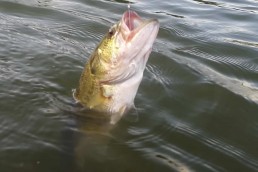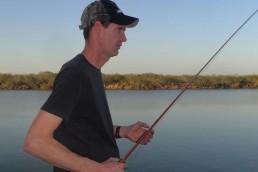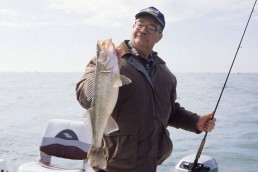Low-light Fishing for Bass
SHARE THIS POST
A lot like deer hunting, success can come early in the morning or late in the evening, and the same holds true for catching bass. Sure, you can catch these throughout the day, but anglers know they need to take advantage of the time they have on the water when the day is just beginning. This is the prime time big bass are caught and numbers are put in the boat. Maybe that is why you see tournament anglers take off like there’s no tomorrow at the beginning of a tournament.
The best times to be on the water are the first and last hours of the day and in other low-light conditions like overcast days. One reason is because baitfish feed at these times and this makes it an opportune time for bass to find an easy meal. Baitfish have poor eyesight, and when they get schooled up in large numbers, it makes it a feeding frenzy for bass. I bet you’ve witnessed the area you’re fishing get raided by baitfish and shortly thereafter bass move in and take a bite at anything. And I bet it was near the time shortly after the sun came up or was setting.
Along with the natural power of a bass, they have great eyesight with lateral lines to detect movement, and also an awesome sense of smell and powerful hearing. Because of their stealth, it does not take much work to eliminate many of the baitfish, especially during low-light conditions. These fish are taking in as much food as possible with as little energy spent as possible. After the sun breaks through the water’s surface and rises more the bass no longer have the advantage. This is when they seek cover and concealment and then ambush baitfish as they swim by.
Because bass are taking a bite out of just about everything in low-light times, I like to fish spinnerbaits, lipless crankbaits and topwater baits. These can be fished quickly and cover a large area, allowing you to come into contact with more fish in a shorter period of time and catch more and bigger fish.
Are you enjoying this post?
You can be among the first to get the latest info on where to go, what to use and how to use it!
Some say this isn’t true when the water temperatures are cold, especially in late winter or early spring. Actually, the fishing can be the same; bass along with baitfish will just be in deeper waters. As long as you are able to get a lure that is similar to what the bass are feeding on and into the depths where bass are feeding, it may not take long to get a strike.
We’ve heard anglers tell their stories about all the fish they’ve caught as soon as they got on the water or the ones about the giant they caught with the first cast, only to believe this would be happening all day and then get disappointed an hour later when the bite dies off. The reason for this is not just luck or a lack thereof. Bass take advantage of factors they know are favorable for them, especially the food buffet that comes from low-light conditions. We need take advantage of this time, and anglers need to be prepared and ready. It might mean setting the alarm clock a little earlier or staying a little later than normal. Because bass are at the top of the food chain, we need to take advantage of any built-in weakness they have.
To sum it up, be opportunistic at low-light periods, as these are the times bass anglers can catch a lot.
MWO
SHARE THIS POST
Did you enjoy this post?
You can be among the first to get the latest info on where to go, what to use and how to use it!
Jason Houser
Jason Houser is an avid outdoorsman from Central Illinois. Houser has been a full-time freelance writer since 2008. He is also the host of Jason Houser Outdoors, airing on the Hunt Channel. He can be found on Facebook at Jason Houser Outdoors or on the web at jasonhouseroutdoors.com.



